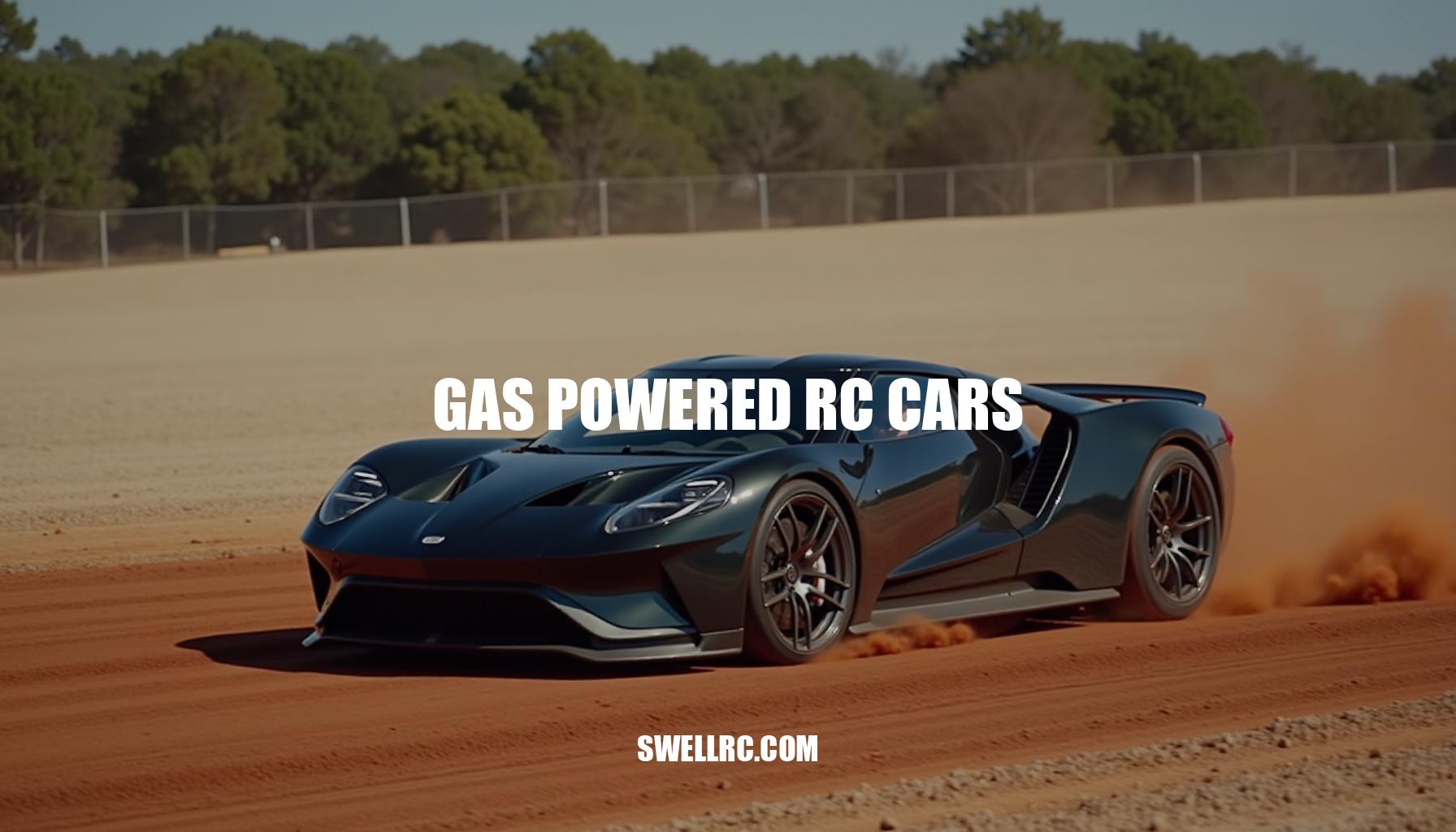Gas Powered RC Cars: A Comprehensive Guide
Pulling that starter cord for the first time, I was greeted by the unmistakable bark of a 2-stroke engine and the sharp blip of the throttle, sending gravel flying with a joyful roar. The sound alone made me realize I was hooked. The unmistakable scent of real fuel filled the air—there was nothing quite like the raw, mechanical pulse of gas powered RC cars.
After countless test drives and engine tweaks, I’ll never forget the rush of that first full-power pass, a stark contrast to the instant but sterile precision of electric counterparts. As an enthusiast who’s tuned, raced, and meticulously maintained these large-scale hobby-grade RC vehicles, I’m excited to share a genuine first-person review of how these machines work, how they perform, and what makes them truly special. Gas powered RC cars, with their intricate 2-stroke engines running on premixed fuel, offer an experience distinct from electric models powered by brushless motors and LiPo batteries.
In this guide, you’ll discover how to choose between gas and electric remote control cars, understand key maintenance essentials, and when each type makes the most sense for your racing or recreational needs.
How Gas Powered RC Cars Work: Beyond the Basics
Imagine your gasoline-powered 2-stroke RC car as a tiny but potent beast eager to leap forward at your command. At its heart lies the 2-stroke RC engine, a marvel of compact power. Unlike a 4-stroke engine, it completes a power cycle in just two strokes of the piston — up and down — thanks to clever reed valve or port timing that controls the flow of the RC fuel mixture.
This premixed fuel combines gasoline with 2-stroke oil, creating the perfect blend for both combustion and lubrication. Starting the engine is straightforward, either by a pull-start cord or an electric starter, bringing this mini combustion chamber to life.
The fuel system is elegantly simple yet precise. Fuel sits in a small tank, feeding through a clunk or pickup that ensures consistent flow regardless of the car’s orientation. A primer bulb or choke helps get the engine breathing during startup.
From here, the fuel travels through delicate lines into the carburetor, where carburetor tuning with high and low needles fine-tunes the air-fuel ratio, assisted by an air filter that keeps debris at bay. This setup lets you dial in peak performance no matter your track.
Now, as you twist the throttle, here’s where the magic truly happens: the engine’s power is transferred through a centrifugal clutch that engages smoothly at higher rpm, preventing stalling at low speeds. This clutch connects to a spur and pinion gear system or a gear differential, distributing power to either two or four wheels (2WD vs 4WD), depending on your model. Brakes, controlled precisely via radio and servo, let you tame the speed with confidence.
When comparing gas vs nitro hobby-grade RC vehicles, gasoline-powered engines shine in torque and runtime, running on cheaper pump gas mixed with oil. Nitro engines, fueled by methanol and nitromethane blends, rev higher and offer sharper throttle responses but require more sensitive tuning and come with higher running costs. Here’s a quick rundown:
| Feature | Gasoline 2-Stroke RC Engine | Nitro Engine |
|---|---|---|
| Fuel Cost | Low (pump gas + oil) | High (specialized methanol blends) |
| Sound | Deep and torquey exhaust note | High-pitched, scream-like revs |
| Maintenance Level | Moderate; simpler carb and clutch work | Higher; sensitive tuning and engine care |
| Run Time | Longer per tank | Shorter, frequent refills needed |
| Scale Realism | Closer to full-size gas engine sound and feel | Sharper throttle response but less torque |
For those eager to dive deeper into specifications and tuning notes, exploring specialized resources on gasoline powered RC engines opens a world of knowledge. Understanding the nuances of your engine, fuel mixture, and drivetrain not only demystifies the technology but also makes every twist of the throttle a thrilling connection to the miniature powerhouse beneath your hands.
Performance and Realism: Why Enthusiasts Swear by Gas RC Cars
Experiencing a 1/5-scale gas RC car is akin to commanding a miniature race car alive with roaring power and tactile feedback. From the moment you crack the throttle, the torque off the line delivers an exhilarating punch, reminiscent of full-scale racing machines. The engine bark and deep exhaust note resonate with a visceral growl, while the subtle vibrations transmitted through the chassis enhance the sensation, making every acceleration a sensory event.
This intimate engine response, paired with the aggressive tire bite, translates into a driving experience that feels remarkably authentic—true adrenaline without artificiality.
Typically, these large-scale RC cars reach stock top speeds between 35–50 mph. However, once equipped with optimized gearing and a tuned pipe, surpassing 60 mph becomes a tangible goal, pushing the limits of gas RC performance. The acting forces don’t stop there; braking is impressively consistent, and the subtle nuances of weight transfer under deceleration fundamentally affect handling dynamics, providing a connection that mirrors real automotive physics.
- Throttle modulation: The linear response curve allows precise power delivery, which is especially invaluable when peeling out of corners or managing traction on varying grip surfaces.
- Control aids: Optional gyro and AVC systems subtly stabilize the chassis, enhancing confidence without diluting raw mechanical feedback.
Delving into examples clarifies how diverse engine architectures influence performance flavor. The gas-powered F1 RC car demonstrates abundant low-end torque, furnishing commanding acceleration at corner exits with a sonorous engine note that fills the senses. In stark contrast, RC F1 nitro models run higher-revving engines offering a more stratospheric powerband, emphasizing precision and rev-happy responsiveness over brute torque, yet delivering similar aerodynamic styling and chassis layout focused on razor-sharp handling and traction.
| Characteristic | Gas-Powered F1 RC | Nitro RC F1 Model |
|---|---|---|
| Torque Off the Line | High, immediate torque for strong launches | Moderate, peaky torque with higher RPM emphasis |
| Engine Note | Deep, throaty bark with rich exhaust growl | Screechy, high-pitched exhaust scream |
| Throttle Modulation | Linear, forgiving power delivery | Responsive but sensitive, requiring finesse |
| Handling & Traction | Weight distribution aids stable corner exit | Light chassis enhances agility at high speed |
Drawing from my own extensive top speed testing and back-to-back trials of various platforms, it’s evident that the interplay between engine character, gearing ratios, and chassis weight distribution substantially transforms corner entry and exit speed profiles. The gas-powered variants, with their torquey engines, often encourage a smooth yet forceful corner exit, while nitro engines demand finely-tuned throttle control to maintain grip and speed through apexes. Ultimately, the fusion of these mechanical elements replicates the harmony and tension found in full-size motorsport, cementing the realism and thrill of these captivating machines.
Top Models and Types: Finding Your Perfect Gas RC Match
If you’re diving into the world of gas-powered remote control vehicles, choosing the right model category to match your passion and skill level is key. Here’s a breakdown by use case across popular types—cars, trucks, boats, planes, helicopters, and exotic collector models—to help you pick your first or next great ride.
Gas RC Cars
Best for: On-road realism enthusiasts and track day racers.
Typical Scale/Engine Size: 1/5-scale platforms with large, durable engines.
Maintenance: Moderate—regular engine tuning and parts replacement required.
Upgrade Potential: High, thanks to solid parts support and numerous performance upgrades.
These large-scale RC cars are perfect if you love precision driving and realistic handling on paved tracks.
Trucks
Best for: Bashers who love big jumps and rough play.
Typical Scale/Engine Size: Varies; often 1/5 or larger scales with robust gas engines.
Maintenance: Moderate to high, depending on terrain and use intensity.
Upgrade Potential: Significant, with both kit and RTR options allowing customization.
For those craving rugged durability, explore the best gas powered RC trucks for top picks and advice.
Boats
Best for: Scale enthusiasts wanting endless runtime and splashy, dramatic rooster tails.
Typical Scale/Engine Size: Various scales with reliable gasoline engines.
Maintenance: Moderate; water exposure demands regular cleaning and engine checks.
Upgrade Potential: Good, focusing on hydrodynamics and speed improvements.
Check out RC boats gasoline favorites for inspiring models.
Planes
Best for: Builders and scale pilots who enjoy long flights and the classic 2-stroke engine sound.
Typical Scale/Engine Size: Medium to large scales with gas-powered motors.
Maintenance: Moderate, requiring careful engine tuning and airframe upkeep.
Upgrade Potential: Considerable, especially for aerodynamic and power enhancements.
Dive deeper with selections of gas RC planes to find a perfect build.
Helicopters
Best for: Precision pilots seeking a challenging but rewarding experience.
Typical Scale/Engine Size: Typically 30-60cc engine sizes.
Maintenance: High; requires detailed mechanical knowledge and regular tuning.
Upgrade Potential: Advanced, focusing on control systems and rotor performance.
Start your journey with reviews and setup guides on gas powered remote control helicopter and check comprehensive gas powered RC helicopter reviews.
Exotic Collector Models
Best for: Collectors and show builders celebrating iconic replicas.
Typical Scale/Engine Size: Varies; often detailed 1/5 or 1/8-scale models.
Maintenance: Low to moderate, focusing on cosmetic upkeep.
Upgrade Potential: Limited, mostly aesthetic or minor performance tweaks.
See stunning examples like the gas powered RC Lamborghini for inspiration in collector RC models.
Maintenance, Fuel, and Longevity Tips
Maintaining your RC engine and drivetrain in top shape requires a disciplined and proven maintenance cadence paired with a hands-on troubleshooting playbook. Here’s a comprehensive approach based on real-world experience that will make you confident in keeping your engines healthy and drivetrains tight.
Fuel Mix & Storage: Always start with fresh pump gasoline blended with a high-quality synthetic 2-stroke oil. The common fuel ratio ranges from 25:1 to 32:1, with a richer mixture during engine break-in and leaning toward the manufacturer’s recommended ratio afterward. Ethanol-free fuel is preferable to minimize deposits and corrosion.
Prepare your premix in sealed containers and rotate your stock regularly to prevent degradation.
Daily (After-Run) Maintenance: After each session, thoroughly clean the air filter to ensure optimal airflow. Inspect fuel lines and clamps for cracks or looseness, and examine the clutch bell and spur gear for wear. Verify gear mesh for proper engagement, and retighten critical fasteners, applying thread locker where appropriate.
This routine air filter service and basic checks prevent most common failures.
Weekly and Seasonal Checks: Every week or at the start of a season, inspect differential components and wheel bearings, replacing if necessary to maintain drivetrain smoothness. Check brake pads for wear and evaluate servo horn and linkage play to ensure crisp controls. Reset and fine-tune your carburetor’s high and low needle settings at operating temperature for consistent performance.
Storage Procedures: Prior to storage, drain the fuel tank completely and run the engine dry to clear residual fuel. Fog the cylinder with after-run oil to prevent corrosion inside the combustion chamber. Store the car with the air filter clean and oiled, and support the tires off the ground to avoid flat spots that can affect handling.
Tuning Quick Hits: Warm your engine fully before tuning. Set the idle carefully so the clutch doesn’t drag, then adjust the low-speed needle to ensure a crisp launch without bogging. The high-speed needle should be tuned for peak power, listening for a faint 4-stroking sound cleaning up at wide-open throttle (WOT).
Regularly check the spark plug color and listen to exhaust notes to guide your tuning decisions.
Diagnostics: If you experience hard starts, verify the choke and primer functionality, inspect the spark plug condition, and check the fuel filter for obstructions. Bogging on launch typically signals a rich low needle setting or a clogged fuel filter. High-temperature power fade can indicate a lean high needle setting or blocked airflow.
Clutch slip often results from bell glaze or failed springs.
Safety: Always operate in well-ventilated outdoor areas, be mindful of hot exhaust components, use fuel-safe containers, and keep proper fire precautions nearby.
For your convenience, here are the 7 must-do RC car maintenance tips to integrate into your routine:
- Use fresh, ethanol-free fuel mixed between 25:1 and 32:1 with quality synthetic 2-stroke oil, and rotate stock regularly.
- Perform daily after-run air filter service and check critical components like fuel lines and clutch parts.
- Inspect differentials, wheel bearings, brakes, and servo linkages weekly or seasonally for optimal drivetrain performance.
- Before storage, drain fuel, run the engine dry, fog with after-run oil, and store with clean, oiled air filters.
- Warm engines fully before tuning; adjust idle, low-speed, and high-speed needles carefully while monitoring spark plug and exhaust sounds.
- Troubleshoot issues promptly by checking choke, spark plug, fuel filters, and clutch condition to avoid prolonged damage.
- Always prioritize safety by running outdoors, handling fuel carefully, and avoiding contact with hot engine parts.
Adhering to these RC car maintenance tips and using this troubleshooting playbook will empower you to keep your engines running smoothly and your drivetrain tight, ensuring top performance and longevity for your RC vehicles.
Gas vs Electric RC Cars: The Real Story
When deciding between gas RC vs electric RC vehicles, it’s vital to weigh factors like acceleration curves, runtime comparison, realism, price comparison, and long-term costs. To help you choose based on hands-on testing, here’s a side-by-side look at key aspects:
| Feature | Electric RC | Gas RC |
|---|---|---|
| Speed | 60–100+ mph potential (instant torque enables rapid acceleration curves) | 35–60+ mph typical (smooth power delivery with slight lag) |
| Run Time | 10–20+ minutes per battery pack (needs recharge between runs) | 30–60 minutes per fuel tank (refuel quickly for extended sessions) |
| Maintenance | Low—minimal upkeep beyond battery care and occasional electronics check | Moderate—requires tuning, engine care, and periodic replacement of parts |
| Realism | Quiet operation; less immersive but highly efficient | Immersive sound and vibration—adds mechanical satisfaction and scale realism |
| Price | Lower entry (~$200–$800 for 1/10 to 1/8 scale) but battery replacements add to long-term costs | Higher upfront (~$500–$1500 for 1/5 large-scale); ongoing fuel costs generally lower than repeated battery replacements |
Insights from practical use reveal that electric RC vehicles excel with their instant torque, producing quick bursts of acceleration that outperform gas in tight scenarios, while demanding less maintenance overall. Conversely, gas-powered models deliver an engaging experience through their roaring engines and rhythmic vibrations, ideal for enthusiasts wanting to learn mechanical tuning or enjoy longer uninterrupted runs.
Consider your use cases carefully:
- Electric RC: Optimal for tight backyard runs or competitive club racing where bursts of speed and low fuss maintenance shine.
- Gas RC: Best suited for large open spaces, hobbyists seeking scale realism, and those who appreciate hands-on tinkering with mechanical components.
From a long-term cost perspective, batteries degrade over time and replacement costs can add up. Gasoline tends to be more economical per run, but keep in mind that both setups incur expenses on spares and tires, which significantly impact maintenance budgets during heavy use. Ultimately, your choice hinges on prioritizing either mechanical satisfaction and immersive realism versus low maintenance and instant electric power.
Conclusion: My Takeaway After a Deep Dive into Gas RC Freedom
Reflecting on this journey, from torque-rich launches that get the adrenaline pumping to hour-long sessions fine-tuning every detail, the gas RC passion has been nothing short of electrifying. Every time I achieve a clean tune, it’s not just about performance—it’s the deep satisfaction that comes from a hands-on hobby where the joy lies equally in the building and the tuning. This mechanical connection turns every wrenching moment into a lesson; each adjustment adds to my understanding and sharpens my skills.
From an enthusiast perspective, here are some key takeaways that keep fueling my drive:
- Patience is paramount: Perfecting the engine mix and tuning elements demands persistence.
- Every tweak teaches: Even minor adjustments reveal new insights about engine behavior.
- The hands-on hobby aspect: Getting under the hood is where theory meets practice, making the experience truly rewarding.
- Community and collaboration: Sharing tips with fellow enthusiasts enriches the learning curve.
After all the fuel burns and late-night engine tuning, here’s what I know for sure—gas RCs aren’t just toys; they’re an experience. They ignite a passion, foster a unique mechanical connection, and transform simple runs into unforgettable adventures. If you’re ready to explore, dive in—the thrill and craft await you.
Frequently Asked Questions
- Are gas powered RC cars faster than electric ones?
Typically no. High-end brushless electric RCs can exceed 70–100+ mph, while most gas 1/5-scale cars run about 35–60+ mph. Gas wins on realism, long sessions, and torque-rich feel; electric often wins outright speed and acceleration. - How long can a gas powered RC car run on one tank?
About 30–45 minutes is common for 23–30cc 1/5-scale cars, with conservative driving stretching to close to an hour. Runtime varies with tank size, tune, gearing, driving style, and terrain. - What’s the best gas powered RC car for beginners?
A 1/5-scale RTR buggy or truck with a 23–26cc engine, pull-start, strong parts support, and simple access to air filter, carb, and clutch. Look for stable handling, reliable radio gear, and a clear manual for tuning and maintenance. - How do you maintain and tune a gas RC engine?
Keep a clean, oiled air filter; use fresh premix (25:1–32:1 with quality 2-stroke oil); warm the engine before tuning; set idle so the clutch doesn’t engage; adjust the low-speed needle for crisp launches and the high-speed needle for peak power with safe temps; inspect clutch, bearings, and brakes regularly. - Are gas powered RC models worth the higher cost?
If you value long runtimes, mechanical engagement, and realistic sound/feel, yes. Upfront costs are higher than many electric setups, but fuel is cheaper per run and the experience is uniquely immersive. If you want low maintenance and compact running spaces, electric may suit you better. - What fuel mix do gas RC cars use?
Unleaded gasoline mixed with quality 2-stroke oil—commonly 25:1 for break-in and 28:1–32:1 for regular running (follow your engine’s manual). Ethanol-free fuel is preferred if available; store premix in sealed containers and use it fresh. - Which is better for racing — nitro or gasoline RC cars?
It depends on class and track. Nitro dominates many 1/8-scale race classes with high-revving engines and lighter cars. Gasoline is standard in 1/5 large-scale racing with longer stints and torquey power. Choose based on the class you plan to race. - How do I start a gas RC car for the first time?
Fill with proper premix; prime the fuel line; set choke on; pull-start until it fires or coughs; open the choke and pull again to start; let it warm up at a fast idle; verify brakes and steering; then fine-tune the carb at operating temperature before running hard.



